Haitao Zhao
Decoding Neighborhood Environments with Large Language Models
May 13, 2025Abstract:Neighborhood environments include physical and environmental conditions such as housing quality, roads, and sidewalks, which significantly influence human health and well-being. Traditional methods for assessing these environments, including field surveys and geographic information systems (GIS), are resource-intensive and challenging to evaluate neighborhood environments at scale. Although machine learning offers potential for automated analysis, the laborious process of labeling training data and the lack of accessible models hinder scalability. This study explores the feasibility of large language models (LLMs) such as ChatGPT and Gemini as tools for decoding neighborhood environments (e.g., sidewalk and powerline) at scale. We train a robust YOLOv11-based model, which achieves an average accuracy of 99.13% in detecting six environmental indicators, including streetlight, sidewalk, powerline, apartment, single-lane road, and multilane road. We then evaluate four LLMs, including ChatGPT, Gemini, Claude, and Grok, to assess their feasibility, robustness, and limitations in identifying these indicators, with a focus on the impact of prompting strategies and fine-tuning. We apply majority voting with the top three LLMs to achieve over 88% accuracy, which demonstrates LLMs could be a useful tool to decode the neighborhood environment without any training effort.
CapHDR2IR: Caption-Driven Transfer from Visible Light to Infrared Domain
Nov 25, 2024
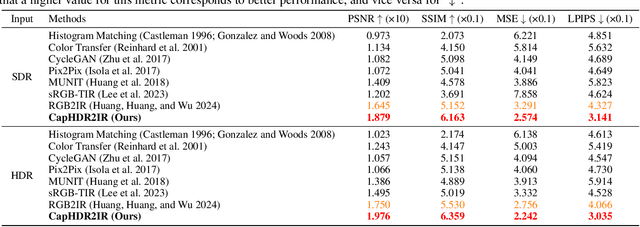


Abstract:Infrared (IR) imaging offers advantages in several fields due to its unique ability of capturing content in extreme light conditions. However, the demanding hardware requirements of high-resolution IR sensors limit its widespread application. As an alternative, visible light can be used to synthesize IR images but this causes a loss of fidelity in image details and introduces inconsistencies due to lack of contextual awareness of the scene. This stems from a combination of using visible light with a standard dynamic range, especially under extreme lighting, and a lack of contextual awareness can result in pseudo-thermal-crossover artifacts. This occurs when multiple objects with similar temperatures appear indistinguishable in the training data, further exacerbating the loss of fidelity. To solve this challenge, this paper proposes CapHDR2IR, a novel framework incorporating vision-language models using high dynamic range (HDR) images as inputs to generate IR images. HDR images capture a wider range of luminance variations, ensuring reliable IR image generation in different light conditions. Additionally, a dense caption branch integrates semantic understanding, resulting in more meaningful and discernible IR outputs. Extensive experiments on the HDRT dataset show that the proposed CapHDR2IR achieves state-of-the-art performance compared with existing general domain transfer methods and those tailored for visible-to-infrared image translation.
Luminance Component Analysis for Exposure Correction
Nov 25, 2024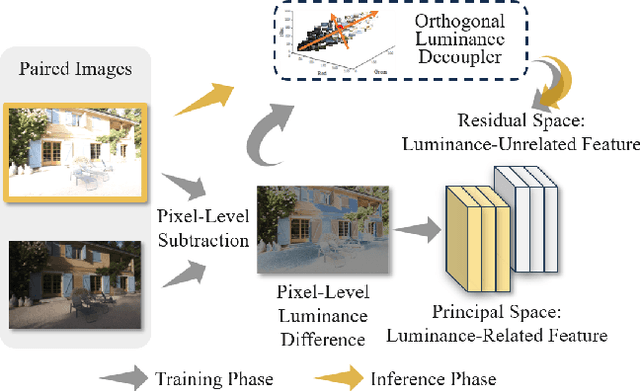

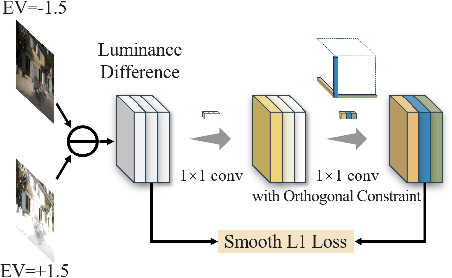

Abstract:Exposure correction methods aim to adjust the luminance while maintaining other luminance-unrelated information. However, current exposure correction methods have difficulty in fully separating luminance-related and luminance-unrelated components, leading to distortions in color, loss of detail, and requiring extra restoration procedures. Inspired by principal component analysis (PCA), this paper proposes an exposure correction method called luminance component analysis (LCA). LCA applies the orthogonal constraint to a U-Net structure to decouple luminance-related and luminance-unrelated features. With decoupled luminance-related features, LCA adjusts only the luminance-related components while keeping the luminance-unrelated components unchanged. To optimize the orthogonal constraint problem, LCA employs a geometric optimization algorithm, which converts the constrained problem in Euclidean space to an unconstrained problem in orthogonal Stiefel manifolds. Extensive experiments show that LCA can decouple the luminance feature from the RGB color space. Moreover, LCA achieves the best PSNR (21.33) and SSIM (0.88) in the exposure correction dataset with 28.72 FPS.
Fair Computation Offloading for RSMA-Assisted Mobile Edge Computing Networks
Jun 16, 2024



Abstract:Rate splitting multiple access (RSMA) provides a flexible transmission framework that can be applied in mobile edge computing (MEC) systems. However, the research work on RSMA-assisted MEC systems is still at the infancy and many design issues remain unsolved, such as the MEC server and channel allocation problem in general multi-server and multi-channel scenarios as well as the user fairness issues. In this regard, we study an RSMA-assisted MEC system with multiple MEC servers, channels and devices, and consider the fairness among devices. A max-min fairness computation offloading problem to maximize the minimum computation offloading rate is investigated. Since the problem is difficult to solve optimally, we develop an efficient algorithm to obtain a suboptimal solution. Particularly, the time allocation and the computing frequency allocation are derived as closed-form functions of the transmit power allocation and the successive interference cancellation (SIC) decoding order, while the SIC decoding order is obtained heuristically, and the bisection search and the successive convex approximation methods are employed to optimize the transmit power allocation. For the MEC server and channel allocation problem, we transform it into a hypergraph matching problem and solve it by matching theory. Simulation results demonstrate that the proposed RSMA-assisted MEC system outperforms current MEC systems under various system setups.
HDRT: Infrared Capture for HDR Imaging
Jun 08, 2024Abstract:Capturing real world lighting is a long standing challenge in imaging and most practical methods acquire High Dynamic Range (HDR) images by either fusing multiple exposures, or boosting the dynamic range of Standard Dynamic Range (SDR) images. Multiple exposure capture is problematic as it requires longer capture times which can often lead to ghosting problems. The main alternative, inverse tone mapping is an ill-defined problem that is especially challenging as single captured exposures usually contain clipped and quantized values, and are therefore missing substantial amounts of content. To alleviate this, we propose a new approach, High Dynamic Range Thermal (HDRT), for HDR acquisition using a separate, commonly available, thermal infrared (IR) sensor. We propose a novel deep neural method (HDRTNet) which combines IR and SDR content to generate HDR images. HDRTNet learns to exploit IR features linked to the RGB image and the IR-specific parameters are subsequently used in a dual branch method that fuses features at shallow layers. This produces an HDR image that is significantly superior to that generated using naive fusion approaches. To validate our method, we have created the first HDR and thermal dataset, and performed extensive experiments comparing HDRTNet with the state-of-the-art. We show substantial quantitative and qualitative quality improvements on both over- and under-exposed images, showing that our approach is robust to capturing in multiple different lighting conditions.
ODCR: Orthogonal Decoupling Contrastive Regularization for Unpaired Image Dehazing
Apr 27, 2024



Abstract:Unpaired image dehazing (UID) holds significant research importance due to the challenges in acquiring haze/clear image pairs with identical backgrounds. This paper proposes a novel method for UID named Orthogonal Decoupling Contrastive Regularization (ODCR). Our method is grounded in the assumption that an image consists of both haze-related features, which influence the degree of haze, and haze-unrelated features, such as texture and semantic information. ODCR aims to ensure that the haze-related features of the dehazing result closely resemble those of the clear image, while the haze-unrelated features align with the input hazy image. To accomplish the motivation, Orthogonal MLPs optimized geometrically on the Stiefel manifold are proposed, which can project image features into an orthogonal space, thereby reducing the relevance between different features. Furthermore, a task-driven Depth-wise Feature Classifier (DWFC) is proposed, which assigns weights to the orthogonal features based on the contribution of each channel's feature in predicting whether the feature source is hazy or clear in a self-supervised fashion. Finally, a Weighted PatchNCE (WPNCE) loss is introduced to achieve the pulling of haze-related features in the output image toward those of clear images, while bringing haze-unrelated features close to those of the hazy input. Extensive experiments demonstrate the superior performance of our ODCR method on UID.
Power Optimization for Integrated Active and Passive Sensing in DFRC Systems
Feb 17, 2024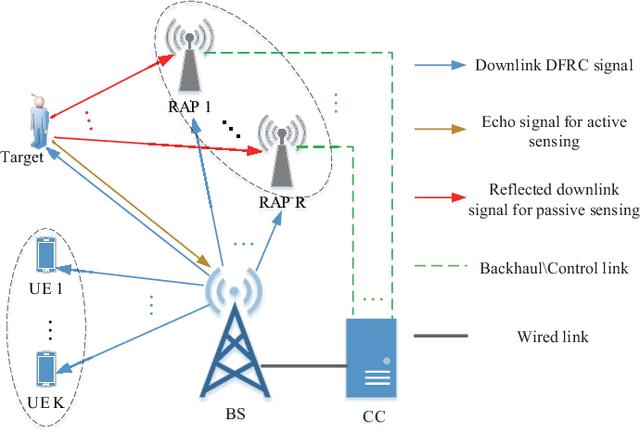


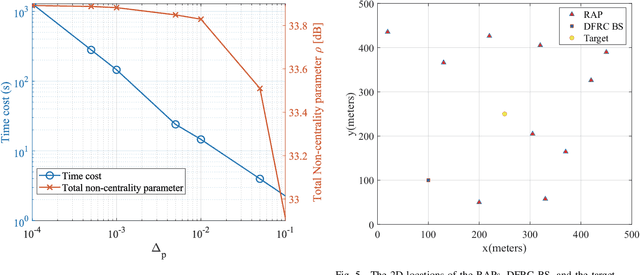
Abstract:Most existing works on dual-function radar-communication (DFRC) systems mainly focus on active sensing, but ignore passive sensing. To leverage multi-static sensing capability, we explore integrated active and passive sensing (IAPS) in DFRC systems to remedy sensing performance. The multi-antenna base station (BS) is responsible for communication and active sensing by transmitting signals to user equipments while detecting a target according to echo signals. In contrast, passive sensing is performed at the receive access points (RAPs). We consider both the cases where the capacity of the backhaul links between the RAPs and BS is unlimited or limited and adopt different fusion strategies. Specifically, when the backhaul capacity is unlimited, the BS and RAPs transfer sensing signals they have received to the central controller (CC) for signal fusion. The CC processes the signals and leverages the generalized likelihood ratio test detector to determine the present of a target. However, when the backhaul capacity is limited, each RAP, as well as the BS, makes decisions independently and sends its binary inference results to the CC for result fusion via voting aggregation. Then, aiming at maximize the target detection probability under communication quality of service constraints, two power optimization algorithms are proposed. Finally, numerical simulations demonstrate that the sensing performance in case of unlimited backhaul capacity is much better than that in case of limited backhaul capacity. Moreover, it implied that the proposed IAPS scheme outperforms only-passive and only-active sensing schemes, especially in unlimited capacity case.
DFR-Net: Density Feature Refinement Network for Image Dehazing Utilizing Haze Density Difference
Jul 26, 2023



Abstract:In image dehazing task, haze density is a key feature and affects the performance of dehazing methods. However, some of the existing methods lack a comparative image to measure densities, and others create intermediate results but lack the exploitation of their density differences, which can facilitate perception of density. To address these deficiencies, we propose a density-aware dehazing method named Density Feature Refinement Network (DFR-Net) that extracts haze density features from density differences and leverages density differences to refine density features. In DFR-Net, we first generate a proposal image that has lower overall density than the hazy input, bringing in global density differences. Additionally, the dehazing residual of the proposal image reflects the level of dehazing performance and provides local density differences that indicate localized hard dehazing or high density areas. Subsequently, we introduce a Global Branch (GB) and a Local Branch (LB) to achieve density-awareness. In GB, we use Siamese networks for feature extraction of hazy inputs and proposal images, and we propose a Global Density Feature Refinement (GDFR) module that can refine features by pushing features with different global densities further away. In LB, we explore local density features from the dehazing residuals between hazy inputs and proposal images and introduce an Intermediate Dehazing Residual Feedforward (IDRF) module to update local features and pull them closer to clear image features. Sufficient experiments demonstrate that the proposed method achieves results beyond the state-of-the-art methods on various datasets.
FoSp: Focus and Separation Network for Early Smoke Segmentation
Jun 07, 2023


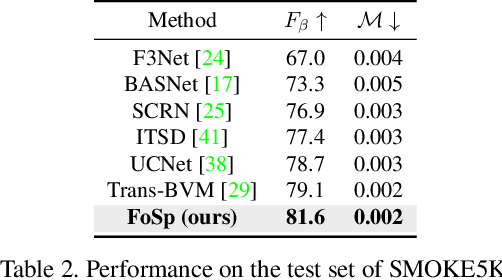
Abstract:Early smoke segmentation (ESS) enables the accurate identification of smoke sources, facilitating the prompt extinguishing of fires and preventing large-scale gas leaks. But ESS poses greater challenges than conventional object and regular smoke segmentation due to its small scale and transparent appearance, which can result in high miss detection rate and low precision. To address these issues, a Focus and Separation Network (FoSp) is proposed. We first introduce a Focus module employing bidirectional cascade which guides low-resolution and high-resolution features towards mid-resolution to locate and determine the scope of smoke, reducing the miss detection rate. Next, we propose a Separation module that separates smoke images into a pure smoke foreground and a smoke-free background, enhancing the contrast between smoke and background fundamentally, improving segmentation precision. Finally, a Domain Fusion module is developed to integrate the distinctive features of the two modules which can balance recall and precision to achieve high F_beta. Futhermore, to promote the development of ESS, we introduce a high-quality real-world dataset called SmokeSeg, which contains more small and transparent smoke than the existing datasets. Experimental results show that our model achieves the best performance on three available datasets: SYN70K (mIoU: 83.00%), SMOKE5K (F_beta: 81.6%) and SmokeSeg (F_beta: 72.05%). Especially, our FoSp outperforms SegFormer by 7.71% (F_beta) for early smoke segmentation on SmokeSeg.
Gradient Sparsification for Efficient Wireless Federated Learning with Differential Privacy
Apr 09, 2023Abstract:Federated learning (FL) enables distributed clients to collaboratively train a machine learning model without sharing raw data with each other. However, it suffers the leakage of private information from uploading models. In addition, as the model size grows, the training latency increases due to limited transmission bandwidth and the model performance degrades while using differential privacy (DP) protection. In this paper, we propose a gradient sparsification empowered FL framework over wireless channels, in order to improve training efficiency without sacrificing convergence performance. Specifically, we first design a random sparsification algorithm to retain a fraction of the gradient elements in each client's local training, thereby mitigating the performance degradation induced by DP and and reducing the number of transmission parameters over wireless channels. Then, we analyze the convergence bound of the proposed algorithm, by modeling a non-convex FL problem. Next, we formulate a time-sequential stochastic optimization problem for minimizing the developed convergence bound, under the constraints of transmit power, the average transmitting delay, as well as the client's DP requirement. Utilizing the Lyapunov drift-plus-penalty framework, we develop an analytical solution to the optimization problem. Extensive experiments have been implemented on three real life datasets to demonstrate the effectiveness of our proposed algorithm. We show that our proposed algorithms can fully exploit the interworking between communication and computation to outperform the baselines, i.e., random scheduling, round robin and delay-minimization algorithms.
 Add to Chrome
Add to Chrome Add to Firefox
Add to Firefox Add to Edge
Add to Edge